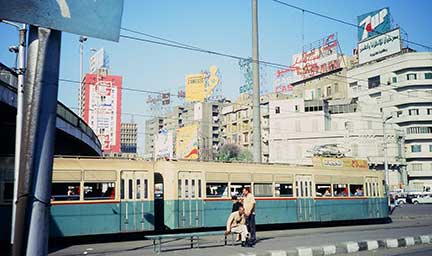 Cairo Traffic
Cairo Traffic
April 18 - 21, 1988
If I ever again become frustrated with slow-moving traffic during rush hour, I will let my mind wander back to Cairo. The largest city in Africa, it's home to at least 16 million people. It was growing by 3,500 people a day when we were there.
Not everyone has cars. That's fortunate, because the existing streets are clogged. Stop-and-go traffic is the norm. But that's not the worst problem.
We couldn't discern any rules of the road, other than that most streets were one-way. Red lights did not necessarily mean "stop" or even "slow". It was the worst of mistakes to believe that a green "walk" light meant it was safe to cross the street. Cars flooded through red lights with horns blaring to warn anyone who might consider getting in the way. Dennis and I joked that some of the horns must be equipped with on-off switches that were locked in the "on" position.
It was an inhospitable environment for pedestrians. At first, we'd wait and wait to cross the street, but eventually we had to get bold, like the natives, stepping out whenever a gap of more than one car length occurred, and dodging our way through up to five lanes of traffic. Sometimes we'd be trapped, standing between unmarked lanes in the midst of traffic for uncomfortable lengths of time. A few drivers enjoyed the game of coming as close to us as they dared. I dreaded crossing streets, and as a pedestrian, was thankful for the large volume of traffic, which served to slow everyone down.
It seemed faster at certain times of the day to walk than take a taxi, and we liked the exercise, if not the wear and tear on our feet. Sidewalks did exist in places, although often as not they were blocked by haphazardly parked cars, pushcarts, or the wares of shop owners and street vendors. Pedestrians therefore shared the streets with cars (not to mention bicycles, motorcycles, horse-drawn taxis, donkey-drawn carts, people-drawn carts, trolleys and buses). We watched policemen stop traffic at a busy intersection to allow a horse-drawn wagon to make a U-turn. Once our taxi passed a donkey-cart in a tunnel, and another time we were amused to watch a man trot a camel over a busy downtown bridge!
 I was amazed to see sleek shining horses with rich harnesses, bells, and other trappings pulling rickety wooden carts loaded with vegetables and other merchandise. Once in a narrow street we had to dodge such a cart carrying a large block of dripping ice as it backed up to allow a mini-van to pass.
I was amazed to see sleek shining horses with rich harnesses, bells, and other trappings pulling rickety wooden carts loaded with vegetables and other merchandise. Once in a narrow street we had to dodge such a cart carrying a large block of dripping ice as it backed up to allow a mini-van to pass.
The donkeys stepped livelier than any I've ever seen, sometimes galloping, with drivers swinging the reins in circles overhead. The animals literally skidded to a stop on the pavement.
It was not necessary to wait for a bus at a designated stop. Would-be passengers caught buses "on the run", chasing them down the street and jumping in (or "on" when there was no more "in"). We didn't learn to do this, as buses were terribly crowded. For 10 piasters ($.04) fare, I guess you can't expect a first class ride.
In Brussels, we'd discovered what we called "minglesections"—circular intersections where 6-8 roads met and in which there seemed to be no rules or order, just numerous vehicles attempting independently to weave their way from one spoke to another. Cairo minglesections made those in Brussels seem well organized!
We thought we might be able to get around some of these frustrations when we discovered a shiny new Metro station in Tahrir Square. There was a map on the wall showing several color-coded subway lines, but the lines ran off the side of the map and everything was written in Arabic. We couldn't tell where the stations were or where the lines led.
We waited in line for "Information."
"Do you have any information on the underground?" asked Dennis. The young man pointed to the unintelligible map on the wall. We looked at each other in dismay.
In an attempt to get some information, I asked, "What is the fare?" His face was blank. "Fare, cost, price, ticket..."
"Oh, yes," he said. "That depends. Where are you going?"
We gave up and went back upstairs to dodge cars.
We later used the underground, as well as the "Nile Bus", a boat that crisscrosses the Nile River in both upstream and downstream directions. Both were bargains at $.10 a ride.
Go on to Egyptian Hustlers
Source: www.SusanCAnthony.com, ©Susan C. Anthony
